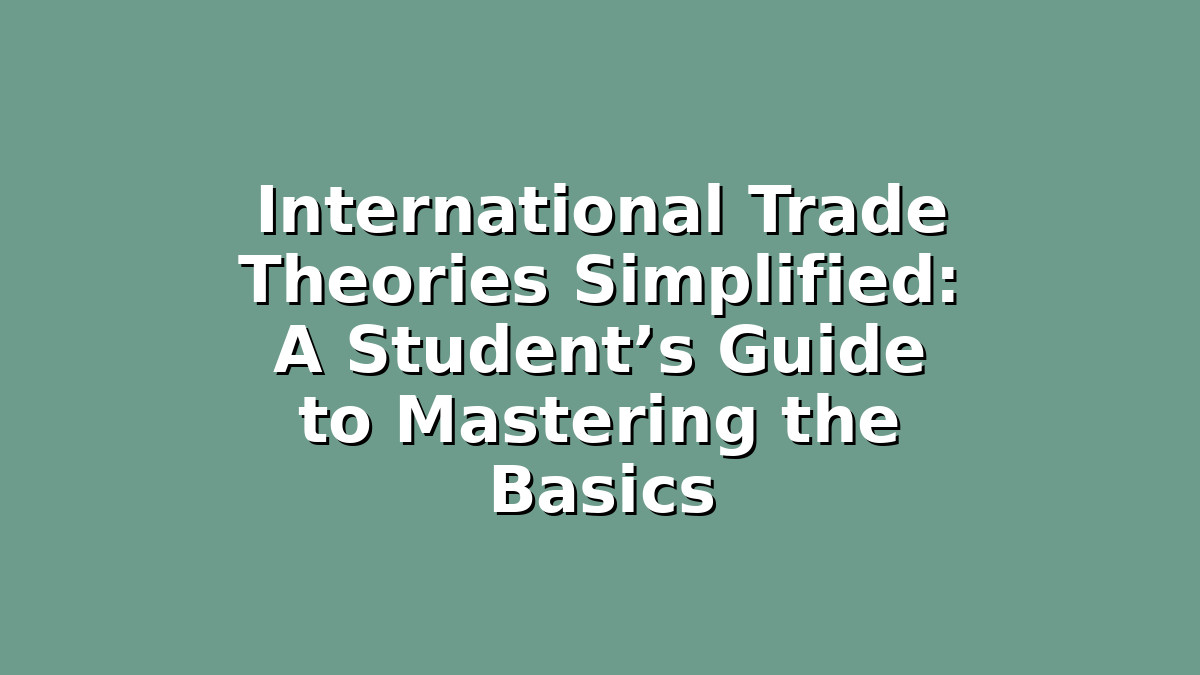Preparing for exams can feel overwhelming, especially when tackling complex subjects like international trade. But understanding the key theories behind international trade doesn’t have to be intimidating. Whether you’re a high school student or a university learner, grasping these concepts can be straightforward and even enjoyable with the right approach. In this article, we’ll simplify international trade theories, provide clear explanations, and share study tips to help you retain the information effectively.
Introduction to International Trade Theories
International trade theories help explain why countries engage in trading goods and services with one another. They provide insight into how nations benefit from trade, what products they export or import, and how specialization impacts the global economy. For students, mastering these theories is crucial for economics exams, business studies, and understanding global markets.
In this guide, you’ll learn about three foundational international trade theories:
1. Absolute Advantage Theory
2. Comparative Advantage Theory
3. Heckscher-Ohlin Theory
Alongside each theory, we’ll share study tips tailored to help you remember important points and apply concepts confidently in exams.
—
1. Absolute Advantage Theory: Understanding the Basics and Effective Memorization
The Absolute Advantage Theory was introduced by Adam Smith in the 18th century. It suggests that a country should produce and export goods that it can make more efficiently than other countries. In other words, if a country can produce a product using fewer resources or at a lower cost than another, it has an absolute advantage.
Example:
If Country A can produce 10 cars using the same resources it takes Country B to produce 5 cars, Country A has an absolute advantage in car production. It makes sense for Country A to focus on cars and trade with Country B for other products.
Study Tips:
– Visual aids: Create simple charts that compare production abilities of two countries. Visualizing the difference helps solidify your understanding.
– Flashcards: Write down the definition, key points, and examples on flashcards. Review these regularly to reinforce memory.
– Teach a friend: Try explaining the theory to a study partner or family member. Teaching helps deepen your grasp of concepts.
Remember, the key term here is “absolute advantage” — which means being the “best” in producing something efficiently.
—
2. Comparative Advantage Theory: Mastering the Most Important Trade Concept
Comparative Advantage is arguably the most important international trade theory, developed by economist David Ricardo. Unlike absolute advantage, this theory explains that even if one country is less efficient in producing all goods, it can still benefit from trade by focusing on what it produces relatively better than others.
How it works:
Comparative advantage is about opportunity cost — what you give up to produce one good over another. A country should specialize in producing goods for which it has the lowest opportunity cost and trade for the rest.
Example:
– Country A can produce either 10 cars or 5 computers.
– Country B can produce either 6 cars or 3 computers.
Even if Country A is more efficient in both, it should focus on cars if its opportunity cost of producing cars is lower than that of computers. Country B should focus on computers and trade cars for them.
Study Tips:
– Practice problems: Work through numerical examples involving opportunity costs. This will help you understand why countries benefit from specializing.
– Summary notes: Write down step-by-step how to calculate opportunity costs. Keep it handy for last-minute revision.
– Mind maps: Use mind maps to link comparative advantage with related concepts like specialization, trade benefits, and opportunity cost.
Comparative advantage might seem complex at first, but practicing calculations and visualizing trade benefits makes it much easier to master.
—
3. Heckscher-Ohlin Theory: Linking Resources and Trade with Real-World Examples
The Heckscher-Ohlin (H-O) Theory expands on earlier trade theories by emphasizing factor endowments — the resources a country has, such as land, labor, and capital. According to the H-O model, countries export goods that use their abundant and cheap factors of production and import goods that require resources that are scarce or expensive domestically.
Example:
– A country rich in capital but poor in labor will export capital-intensive goods (like machinery) and import labor-intensive goods (like textiles).
– Conversely, a labor-rich, capital-poor country will specialize in labor-intensive products.
Study Tips:
– Relate to current events: Look at real-world trade examples. For example, how does China’s abundant labor influence its exports?
– Create comparison tables: Compare countries based on their resource endowments and match them with the goods they export or import.
– Use case studies: Summarize case studies from textbooks or online resources that show the H-O theory in action.
Understanding the H-O theory helps you connect theoretical knowledge with the practical workings of the global economy.
—
Conclusion: Simple Steps to Master International Trade Theories
International trade theories form the backbone of global economic understanding. By focusing on Absolute Advantage, Comparative Advantage, and the Heckscher-Ohlin model, you get a comprehensive view of why and how countries trade.
To succeed in exams:
– Break down complex theories into simple, manageable parts.
– Use visual aids, flashcards, and practice problems to reinforce learning.
– Link theory to real-world examples to make concepts memorable.
– Teach or discuss these theories with peers to boost confidence.
Remember, consistent revision is key. Don’t be discouraged if you don’t grasp everything immediately—practice and patience will pay off. You’ve got this!

Responses